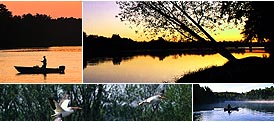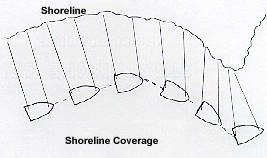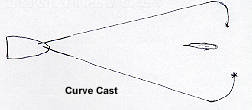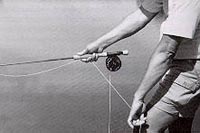

Alligator Hunting: A One of a Kind Experience -
Why They Call it Hunting Instead of Killing -
Florida's Other Crab - by Kris Thoemke
The Waiting Game - by Kris Thoemke
Mounted Memories - by Kris Thoemke
Eco-Touring in Collier County - by Kris Thoemke
Beyond the Largemouth Bass - by Kris Thoemke
Tying One On -- Some thoughts on how to get started tying your own flies -- by Kris Thoemke
The Big Cypress: Adventures in a Vast Wilderness
Four Strokes on the Water -- The sound of the future for marine outboards is likely to be much quieter --
Birding Big Cypress Swamp and the 10,000 Islands --
Recycling Your Fish -- by Kris Thoemke
Peace, Paddle and Hunt -- by Kris Thoemke
by Kris Thoemke
by Kris Thoemke
-- Kris Thoemke spends the day exploring the Big Cypress National Preserve with Preserve biologist Debra Jansen
by Kris Thoemke
by natural history writer and photographer Jeff Ripple
A Basic Guide to Saltwater Fly Fishing in Southwest Florida
C 1997, Don Phillips
Chapter 10 - Presenting & Retrieving the Fly
OK, so now you are in the right place at the right tide, and are equipped with the proper tackle
and fly. The only thing remaining is to get the fly to where the fish is feeding. Your guide has
put you in a good position; not too close so as to spook the fish and yet not so far as to require an
unrealistically long cast. If you can't get the fly to the fish accurately and with some degree of
delicacy your investment and preparation have been wasted. Conversely, you can often have the
worst of equipment and flies, but still catch fish if you can present and retrieve the fly in a
competent manner.
One can read all the literature and query all the experts, but the bottom line for good presentation
and retrieval is experience and practice. You need to put in your time on the water, learn by your
mistakes and practice on the lawn to master your casting ability. It's beyond the scope of this
writing to actually teach casting; an hour or so with a competent instructor will give you the
fundamentals upon which to base your personal practice sessions. I can't overemphasize the
need for practice. Fly casting is no different than golf; you need to "groove" your swing in order
to train your muscles to work together the same way, swing after swing. This chapter will
concentrate on the "types" of casts needed in certain situations, and I'll leave the "how-to" for the
casting field.
Let's first get into the subject of presentation. The fly should be delivered at the right place and
with the right amount of "splash". Usually, this means as little splash as possible. Sometimes,
however, you will want to create some noise to get the fish's attention. If you will remember, in
Chapter 3 I discussed the need for the rod tip and line to travel a fairly straight line, parallel to the
water, to result in a good cast. In practice, that straight line should be tilted forward so that the rod tip and line start out over your head, with the line, leader and fly ending up about 1-2 feet
above the water surface. This way, the leader fully straightens, the fly suddenly stops and lightly
drops a short distance to the water surface, creating little disturbance. Similarly, the line point
gently falls a short distance. This is perhaps the classical fly cast, the one that we usually try to
achieve. If an obstruction prevents you from casting close to the fish and you can only get to
within 10 feet, then you might want to cast more downward, at a steeper angle. This would
permit you to "slap" the fly on the water at a high velocity (to get the fish's attention) when the
leader straightens out. This slap can be particularly noisy if you increase the angle of your rod
tip/line path by elevating your backcast.
rod tip and line start out over your head, with the line, leader and fly ending up about 1-2 feet
above the water surface. This way, the leader fully straightens, the fly suddenly stops and lightly
drops a short distance to the water surface, creating little disturbance. Similarly, the line point
gently falls a short distance. This is perhaps the classical fly cast, the one that we usually try to
achieve. If an obstruction prevents you from casting close to the fish and you can only get to
within 10 feet, then you might want to cast more downward, at a steeper angle. This would
permit you to "slap" the fly on the water at a high velocity (to get the fish's attention) when the
leader straightens out. This slap can be particularly noisy if you increase the angle of your rod
tip/line path by elevating your backcast.
How close to the fish should you attempt to place the fly? This depends on the situation. If the
fish is fairly stationery, in relatively clear water, and he's not acting spooky or uneasy, I would
recommend that you put the fly about 3-5 feet in front of him with as little splash as possible.
Extend that distance to 5-8 feet in front of him if he's moving in that direction or if he's in very
skinny water and is likely to be nervous. If he's moving away from you, you should cast 3-5 feet
to one side or the other, whichever will keep the line and leader from crossing over his back or
line of sight. In this situation, you should cast the fly only far enough so that the fish can see it
when it lands. Make sure that you don't place the fly in a position so that when you retrieve it, it
will be coming toward the fish. This is a most unlikely scenario, and one to which the fish is
likely to respond by getting out of there. If your fish is a few feet below the water surface or if
the water is quite cloudy, I wouldn't hesitate to drop the fly closer to him, or in fact right over
him.
The preceding two paragraphs presume that you can see the fish; a decided advantage in this
sport. Sometimes you can see their swirls or wakes, which is just as good. Often, however, you
are fishing "blind"; i.e. fishing good-looking spots, but not knowing if there are fish below or in
back of some cover. In this situation the strategy for catching the most fish is simply maximum
coverage. What you want to do is to cover as much good-looking water as practical in a short
period of time. Coverage by the way means having your fly in the water, being retrieved. Fish
are not caught while you're casting!
Suppose you and your fishing partner are using your electric trolling motor to follow an
attractive-looking piece of mangrove shoreline about 40 feet away. The best way to cover this
water is for both of you to cast close to or up into the mangroves with casts perpendicular to the shoreline. And, you should try to time your casts with your boat's progress so that a fly is
presented every 5-10 feet along the shoreline; perhaps every 2-5 feet in areas that provide
particularly good fish cover. In this instance, it's a good idea for both anglers to be fishing quite
different flies, to gain insight on what patterns seem to be working the best. This type of
coverage would also apply to fishing the edges of grass flats, sand bars, oyster bars, etc.
Another effective way to cover a shoreline or edge is to cast parallel to the shoreline when you're
quite close to the mangroves. In this instance however you should deliver multiple casts, each
successively further out from the shore. Then, move the boat somewhat short of the landing
spots of your casts and repeat the sequence. This provides good water coverage, and gives fish
more than one opportunity to go after the fly. Similar "pattern" casts can be used to cover holes,
channels, etc.
shoreline. And, you should try to time your casts with your boat's progress so that a fly is
presented every 5-10 feet along the shoreline; perhaps every 2-5 feet in areas that provide
particularly good fish cover. In this instance, it's a good idea for both anglers to be fishing quite
different flies, to gain insight on what patterns seem to be working the best. This type of
coverage would also apply to fishing the edges of grass flats, sand bars, oyster bars, etc.
Another effective way to cover a shoreline or edge is to cast parallel to the shoreline when you're
quite close to the mangroves. In this instance however you should deliver multiple casts, each
successively further out from the shore. Then, move the boat somewhat short of the landing
spots of your casts and repeat the sequence. This provides good water coverage, and gives fish
more than one opportunity to go after the fly. Similar "pattern" casts can be used to cover holes,
channels, etc.
There are literally dozens of specialty casts that find application in freshwater fly fishing, and
many of them are also applicable to our backwater fly fishing. It would take too much space to
describe these techniques in detail, but I'll at least outline their features. The most common of
the specialty casts is the "double-haul" which is used to create greater line speed and therefore
longer distance. In the double-haul, the line hand is used twice to provide line acceleration; once
on the backcast and again during the forward, delivery cast. In both instances, a 1-2 foot strip or
"haul" of the line adds additional line speed just at the time when the casting loop is beginning to
form.
The "roll" cast is an excellent way to deliver the fly to the target when there are obstructions
behind you which would prevent a normal backcast. You begin the roll cast by having about 20-30 feet of floating line in front of you. You then raise the rod until it's about in the 1 o'clock
position, hesitate, and then make a short but brisk forward cast. The surface tension between the
line and the water temporarily anchors the line, and starts a large, rolling loop of line coming off
the water and feeding the casting loop. Another method of dealing with rearward obstructions is
to execute the "steeple" cast. Here, your backcast is unusually high, to clear the obstructions and
your forward cast is very steep. Don't make the mistake of attempting to make a forward cast
parallel to the water following a high backcast; this is a sure formula for a severe tailing loop that
might bury the hook in the back of your neck.
Another very useful cast is called the "reach" cast, which has several applications. First, it is
used when you want the retrieved fly to follow a path other than straight back to you. In the
situation where your boat is 8-10 feet off from a shoreline, your cast can place the fly right next to shore but a normal retrieval will pull the fly progressively away from the shore. With the
reach cast, you start the cast in the normal way, but as the line is leaving the rod tip you swing the
rod to the side and down so that it's now pointing toward the shore, perpendicular to the original
line travel path. If done correctly, the completed cast will result in the line, leader and fly laying
on the water mostly parallel to the shoreline, permitting a retrieve that stays pretty close to the
shoreline.
to shore but a normal retrieval will pull the fly progressively away from the shore. With the
reach cast, you start the cast in the normal way, but as the line is leaving the rod tip you swing the
rod to the side and down so that it's now pointing toward the shore, perpendicular to the original
line travel path. If done correctly, the completed cast will result in the line, leader and fly laying
on the water mostly parallel to the shoreline, permitting a retrieve that stays pretty close to the
shoreline.
Another use for the reach cast is when you are stationary in a modest current and want the fly to
sink a foot or so before retrieving. A normal cast will result in the current acting on the line and
leader to create a "belly" pulling on the fly and keeping it on the water's surface. If you perform
a reach cast across the current, swinging the rod in the upstream direction and then following the
line's progression downstream with your rod tip, the fly will have time to sink with a relatively
slack line. If you are in the same situation except facing somewhat downstream, the "puddle"
cast will give you the necessary line slack to permit the fly to sink. Here, you purposely aim the
cast 15-20 feet in the air, letting the leader and fly collapse in a heap. The current will move the
fly downstream and permit it to sink until the leader slack is taken up. The main problems with
this cast are that it's hard to control in a cross-wind, and if a fish strikes soon after the fly hits the
water, you're in no position to be able to set the hook. Another cast which gives the fly slack line
to permit sinking is the "mending" cast, usually used when you're casting across the current. For
the mending cast you make a normal cast, but immediately drop the rod tip and line to the water
and then throw a mending loop in the upstream direction before the current has a chance to put a
belly in the line. This technique is similar to the reach cast in that it gives the line plenty of time
to drift with the current before it begins to tug on the fly.
There are several specialty casts which help dealing with the wind. First, is the double- haul, or
any other casting technique which will increase line speed. Higher line speeds penetrate an
opposing wind better and minimizes side drift in crosswinds. Another technique for obtaining
higher line speed is using a high backcast/low forward cast into a headwind. A headwind assists
in straightening your high backcast and gravity helps you get a high line speed on the forward
cast. Sidearm casting from a low position can often compensate for a strong wind, since the
wind is never as strong 1-2 feet from the water surface. Incidentally, sidearm casting can also be
quite helpful in penetrating under a mangrove canopy, since you've turned the loop sideways for
a lower vertical profile. Crosswinds can be particularly difficult to deal with if the wind is
coming from your casting-arm side and if you aren't yet skilled enough to get high line speeds.
In order to prevent putting the hook in your ear, you can try different alternatives. First, the
sidearm cast can often compensate for the wind. Second, you can use the sidearm
backcast/overhead forward cast, which keeps the fly about a rod's length away from you on the
backcast and downwind from you if it drifts on the forward cast. The only problem with this cast
is that it requires perfect timing for proper execution, since you're changing casting planes. A
third technique is to cast cross-handed, so that most of the rod and all of the line and the fly
remains downwind from you. A fourth method is to turn around with your back to the target and
release your backcast to deliver the fly to the target. Fifth, if you practice you can learn to cast
with the opposite hand, and thus have another way to keep the fly (and that sharp hook)
downwind from you.
Another cast which can be helpful from time to time is the "curve" cast. Here, instead of ending
up with a cast which forms a straight line between the rod tip and the fly, the fly, leader and the
fly line point will actually curve to the right or to the left. There are several ways to execute this
cast, but I find the easiest is to execute a sidearm cast with a wide loop. For a right-handed
caster, if you wanted to get a curve to the right you purposely cast with a slow line speed and let
the casting loop fall on the water, the loop never completely unrolling. To achieve a left-hand
curve, you would still cast a wide sidearm loop but at a higher line speed, and then give a quick pull with your line hand just before the line point fully unrolls. This in effect "kicks" the fly over
to the opposite side of the line. The ideal circumstances for using curve casts are when you are
casting toward a laid-up (resting) tarpon facing away from you. Here you try to place the fly 3-5
feet to the side of his head and the line point an additional 3-5 feet away. Thus, the line is quite a
distance from the tarpon and when you retrieve the fly, it starts out moving directly away from
him.
pull with your line hand just before the line point fully unrolls. This in effect "kicks" the fly over
to the opposite side of the line. The ideal circumstances for using curve casts are when you are
casting toward a laid-up (resting) tarpon facing away from you. Here you try to place the fly 3-5
feet to the side of his head and the line point an additional 3-5 feet away. Thus, the line is quite a
distance from the tarpon and when you retrieve the fly, it starts out moving directly away from
him.
The preceding paragraphs on casting are not very useful to someone just starting out to learn fly
casting without first getting some good fly casting demonstration and instruction. Make sure that
your instructor covers these casts and then practice them on your own until you can confidently
use them on the water.
In retrieving the fly, there are only a few very basic recommendations which apply to most fishing
situations. One such recommendation is to aim the rod tip down toward the water, pointing at the place where the line is coming off the water. In this way, you have the most direct
connection to the fly (and the fish when he strikes) and you can both feel an unseen strike and
quickly create additional line tension if you want to set the hook deeper. If the rod is pointing
anywhere else other than at the line/water junction, three things will happen. First, when you
strip in line the rod tip will bend, dampening your stripping efforts and reducing fly velocity.
Second, between strips the rod tip will bounce back and forth, creating periodic line slack and
masking any unseen fish strikes. Third, when a fish does strike he'll flex the rod tip, cushioning
the impact and possibly preventing hook penetration.
the place where the line is coming off the water. In this way, you have the most direct
connection to the fly (and the fish when he strikes) and you can both feel an unseen strike and
quickly create additional line tension if you want to set the hook deeper. If the rod is pointing
anywhere else other than at the line/water junction, three things will happen. First, when you
strip in line the rod tip will bend, dampening your stripping efforts and reducing fly velocity.
Second, between strips the rod tip will bounce back and forth, creating periodic line slack and
masking any unseen fish strikes. Third, when a fish does strike he'll flex the rod tip, cushioning
the impact and possibly preventing hook penetration.
Another fairly standard recommendation is to perform the line stripping (retrieval) approximately
as shown in the accompanying photograph. The rod is held loosely in one hand, with the line draped over one or two fingers of that same hand. The opposite hand is then used to pull or strip
the line down and away from the rod hand, in repeated strips. Like casting, it takes practice to be
able to retrieve line in various ways and still keep control of the line for setting the hook or
picking up for casting.
draped over one or two fingers of that same hand. The opposite hand is then used to pull or strip
the line down and away from the rod hand, in repeated strips. Like casting, it takes practice to be
able to retrieve line in various ways and still keep control of the line for setting the hook or
picking up for casting.
In stripping or retrieval there are several variables which are worth noting. All prey do not move
in the same way, nor does a particular specie move the same way under all circumstances. Most
baitfish move with repetitive bursts of speed separated by very short periods of gliding. Since
the angler is usually not privy to the specific antics of the prey in the immediate fishing area, he
must experiment until he finds a winning formula. What are the variables in the formula? Well,
first there is the length of the bursts of speed or the distance of an individual strip. In calm, clear
water I like to start out trying mini-strips of only a few inches in length. If this approach isn't
enticing strikes then I'll lengthen the strips gradually, sometimes up to as much as 3 feet.
Another variable is the speed of the strip; baitfish not under stress will move fairly slow and the
opposite if they're being chased by a predator. A third variable is the dwell-time or pause
between strips. An injured baitfish will often be motionless in between bursts of speed. A
baitfish in a current will also do a lot of gliding between bursts of speed. Imitating the behavior
of shrimp or crabs introduce additional considerations. When they're drifting helplessly in a
current, they're not really swimming unless danger motivates them to escape. Normally, the
crustacean's way of escaping is to get to the bottom and dig in or to hunker down in some crevice
or clump of grass.
And so, try different combinations and see what works. That doesn't mean that the same
combination will work tomorrow or next week. But do vary your retrieves and try to imagine
how your fly looks in the water and how you'd like to have it behave during retrieval. If you're
really ambitious, watch how your flies look while you're retrieving them in a swimming pool or a
bathtub. If you'll do this you may get some snide remarks from your family, but you'll also get
some ideas on retrieval techniques and hints on fly pattern improvements!
Next Article - Boats for Fly Fishing
Table of Contents












